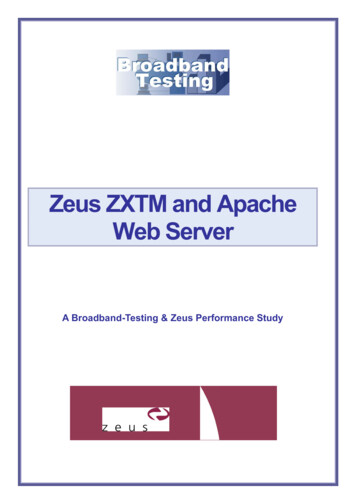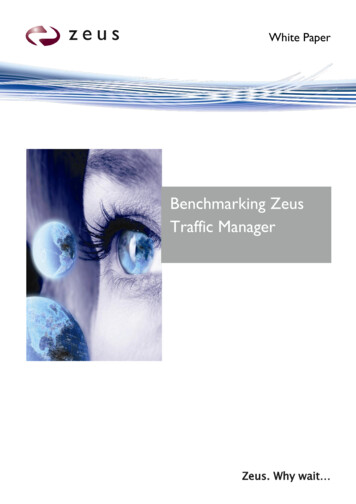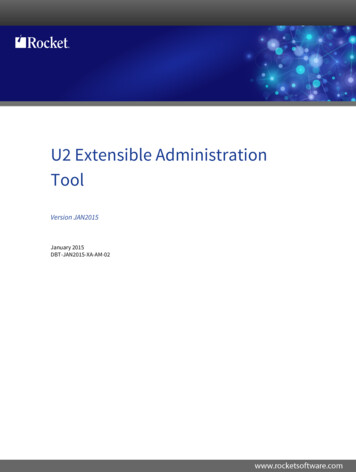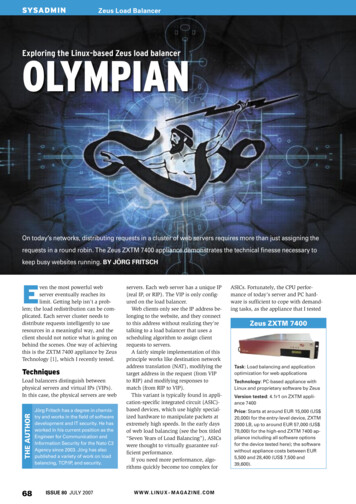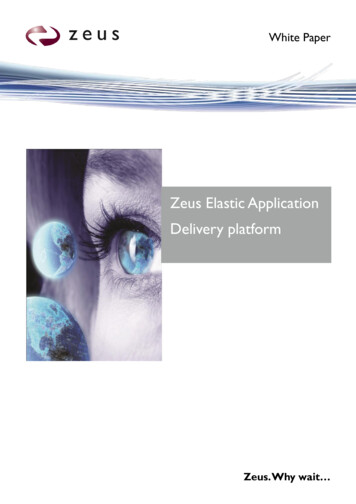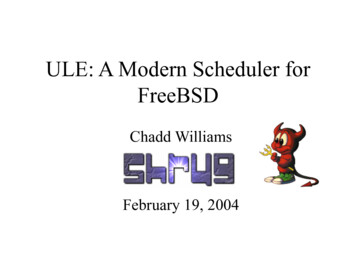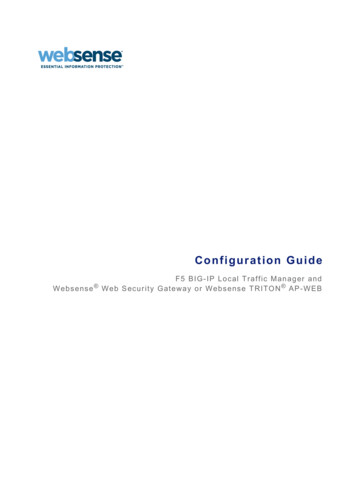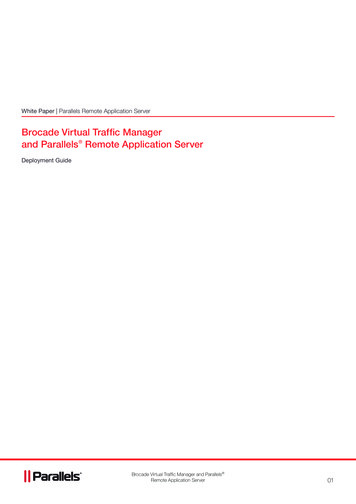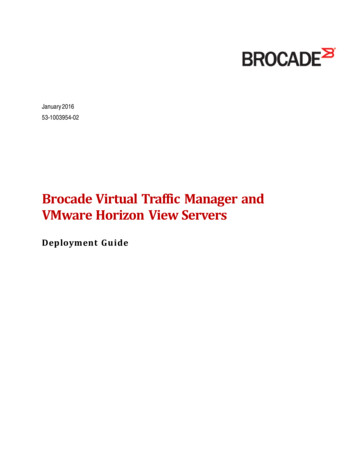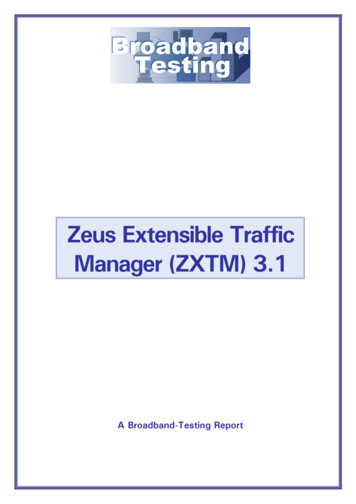
Transcription
Zeus Extensible TrafficManager (ZXTM) 3.1A Broadband-Testing Report
First published February 2005 (V1.0)Published by Broadband-TestingLa Calade, 11700 Moux, Aude, FranceTel : 33 (0)4 68 43 99 70Fax : 33 (0)4 68 43 99 71E-mail : info@broadband-testing.co.ukInternet : HTTP://www.broadband-testing.co.uk 2005 Broadband-TestingAll rights reserved. No part of this publication may be reproduced, photocopied, stored on a retrieval system, or transmitted without theexpress written consent of the authors.Please note that access to or use of this Report is conditioned on the following:1.The information in this Report is subject to change by Broadband-Testing without notice.2.The information in this Report, at publication date, is believed by Broadband-Testing to be accurate and reliable, but is not guaranteed. All useof and reliance on this Report are at your sole risk. Broadband-Testing is not liable or responsible for any damages, losses or expenses arisingfrom any error or omission in this Report.3.NO WARRANTIES, EXPRESS OR IMPLIED ARE GIVEN BY Broadband-Testing. ALL IMPLIED WARRANTIES, INCLUDING IMPLIEDWARRANTIES OF MERCHANTABILITY, FITNESS FOR A PARTICULAR PURPOSE AND NON-INFRINGEMENT ARE DISCLAIMED ANDEXCLUDED BY Broadband-Testing. IN NO EVENT SHALL Broadband-Testing BE LIABLE FOR ANY CONSEQUENTIAL, INCIDENTAL ORINDIRECT DAMAGES, OR FOR ANY LOSS OF PROFIT, REVENUE, DATA, COMPUTER PROGRAMS, OR OTHER ASSETS, EVEN IFADVISED OF THE POSSIBILITY THEREOF.4.This Report does not constitute an endorsement, recommendation or guarantee of any of the products (hardware or software) tested or thehardware and software used in testing the products. The testing does not guarantee that there are no errors or defects in the products, or thatthe products will meet your expectations, requirements, needs or specifications, or that they will operate without interruption.5.This Report does not imply any endorsement, sponsorship, affiliation or verification by or with any companies mentioned in this report.6.All trademarks, service marks, and trade names used in this Report are the trademarks, service marks, and trade names of their respectiveowners, and no endorsement of, sponsorship of, affiliation with, or involvement in, any of the testing, this Report or Broadband-Testing isimplied, nor should it be inferred.
TABLE OF CONTENTSZXTM 3.1 REPORT – EXECUTIVE SUMMARY. 1INTRODUCTION – LAYER 7: ONLY THE BEGINNING. 2ZXTM 3.1 – FEATURES AND FUNCTIONALITY OVERVIEW. 3What Exactly Is ZXTM? . 3Key Layer 7 Features . 4Features Previously Highlighted. 4New Feature Highlights . 5Management Interface. 5Rate Shaping . 6Client (Connection) Aggregation . 6Inbound And Outbound Event-Based Decisions. 7Content Masking. 8Request Buffering. 10Compression . 11ZXTM Feature Test: Sample Scenarios . 13Scenario 1: Avoiding The Dreaded “Page Not Found” Syndrome . 13Scenario 2: Transparently Repairing Broken Website Images . 13Scenario 3: Using Google As Your Own Site Search Engine . 14ZXTM 3.1 PERFORMANCE TESTS . 17Test Overview. 17Requests Per Second. 18Throughput . 19SSL . 19Compression . 21OVERALL SUMMARY. 22APPENDIX: THE TESTBED DETAILS. 23TABLE OF FIGURESFigure 1 – ZXTM Within The Backend Network . 4Figure 2 – The Revised ZXTM GUI . 5Figure 3 – Inbound and Outbound Event Control . 8Figure 4 – L7 Content Masking Example – Zeus Rival. 9Figure 5 – L7 Content Masking Example – ZXTM TrafficScript. 10Figure 6 – Request Buffering – WebSphere Example. 10Figure 7 – Making Intranet Server Available As Extranet . 14Figure 8 – Zeus.com Search Engine . 15Figure 9 – The SOAP Response . 16Figure 10 – The SOAP Response Formatted Into HTML . 16Figure 11 – Performance Chart: Requests Per Second . 18Figure 12 – Performance Chart: Throughput. 19Figure 13 – Performance Chart and Table: SSL Transactions Per Second . 20Figure 14 – Performance Chart and Table: Compression . 21Figure 15 – Spirent WebAvalanche 2500. 23Figure 16 – Creating A WebAvalanche Test . 24
Broadband-TestingBroadband-Testing is Europe’s foremost independent network testing facility andconsultancy organisation for broadband and network infrastructure products.Based in the south of France, Broadband-Testing offers extensive labs, demo andconference facilities. From this base, Broadband-Testing provides a range of specialistIT, networking and development services to vendors and end-user organisationsthroughout Europe, SEAP and the United States.Broadband-Testing is an associate of the following: NSS Network Testing Laboratories (specialising in security product testing) Broadband Vantage (broadband consultancy group) Limbo Creatives (bespoke software development)Broadband-Testing Laboratories are available to vendors and end-users for fullyindependent testing of networking, communications and security hardware andsoftware.Broadband-Testing Laboratories operates an Approval scheme which enables productsto be short-listed for purchase by end-users, based on their successful approval.Output from the labs, including detailed research reports, articles and white papers onthe latest network-related technologies, are made available free of charge on our website at HTTP://www.broadband-testing.co.ukThe conference centre in Moux in the south of France is the ideal location for salestraining, general seminars and product launches, and Broadband-Testing can alsoprovide technical writing services for sales, marketing and technical documentation,as well as documentation and test-house facilities for product development.Broadband-Testing Consultancy Services offers a range of network consultancyservices including network design, strategy planning, Internet connectivity andproduct development assistance.
Broadband-Testing Zeus ZXTM 3.1 ReportZXTM 3.1 REPORT – EXECUTIVE SUMMARYWith ZXTM, Zeus is looking to enter the Layer 7 trafficmanagement market in a different way to that taken by the playersto date. Zeus has forcedly – and correctly – come to the Layer 7market from an intelligent software perspective, and at a verycompelling price:performance point.Intelligent traffic management is what ZXTM is all about. Therefore,in order to really make this a really flexible tool, Zeus has createdthe TrafficScript language to define rules with. This has thecapability to inspect all aspects of the incoming request, from thesource and destination port and IP address to the type and actualcontent of the traffic. TrafficScript also supports DTD and XSLTXML processing.ZXTM has a number of interesting and unique features. Theseinclude the “draining nodes” feature which lets you gracefully takeservers out of an active pool without cutting user connections.Another is the “Diagnose” feature which ensures that yourconfiguration is correct, before you deploy it.ZXTM has extensive redundancy and resilience built-in, whichexceeds the current standard for this product class. It hasdeveloped what it calls N M scalability where near infiniteredundancy and scalability is achieved. Moreover, adding anadditional ZXTM to a cluster is simple, as a new ZXTM isautomatically detected by the existing cluster and the configurationis automatically replicated. So this makes scalability very costeffective (you only have to buy one additional ZXTM if that’s all youneed), and very easy at the same time.Performance – measured across a range of metrics, in real-worldsituations, proved both good in class and excellent on aprice:performance basis. Zeus’ N M scalability suggests that thislevel of performance can continue to increase in direct relation tothe addition of further ZXTM servers. Due to the constraints of ourtest bed in this instance, we were unable to reach the limits of adual ZXTM configuration, but look out for a total scalability test inthe near future.Not only is ZXTM very competitive on a price:performance basis,but equally important here is that, despite this price advantage,ZXTM has class-leading features.Page 1
Broadband-Testing Zeus ZXTM 3.1 ReportINTRODUCTION – LAYER 7: ONLY THE BEGINNINGThere’s been a lot of talk over the years about what constitutes a Layer 7device.What it is not, is load-balancing. That is a Layer 4 application and a veryworthy one at that. But what is really required, in addition, is to be able tomanipulate any application data at L7 and talk directly to the applicationsand network services. Now we are talking about a revolutionary change innetworking, where it becomes a software technology, not one with a limitedlifespan courtesy of the hardware and available bandwidth technologies.This means that there are no physical limits to what you can do and whereyou can go. It creates a truly ubiquitous development platform which allowsthe network to be changed and developed constantly, without the samekind of impact there is now when making physical additions and changes.Hardware becomes a simple extension of the network logic. The intelligentnetwork takes it and manages it directly, in association with the applicationsand services running across it. It’s what at Broadband-Testing we’re calling“the future of networking” and I have personally spoken about thisdevelopment on panels and at seminars over the past 12 months and metwith a very positive – and interested – reaction from press and analystsalike. And getting these guys on your side is no bad thing So, from my perspective, we are talking about the START of the real L7product phenomenon, not the end. And we also need to look at who needsL7 technology. To date the products have been targeted almost exclusivelyat service providers, search engines, portals, carriers all the top-end,service-oriented guys. But at a (far) lower entry price, the world of mediumenterprise computing has many of these same requirements – serveroptimisation (TCP offload), application optimisation (compression etc), afundamental security (for example, Denial of Service attack) foundation andthe ability thereafter to manipulate data to optimise performance further.It’s all about getting a cost/sales model that gives this market a product atthe right price while still maintaining sufficient margins as the vendor tomake real money. We’re not talking about loss leader products here butmoney-making products in their own right. The Internet (i.e. direct salesacross ) is the perfect vehicle here, but how many of the existing L7product vendors can move down to this model and make a profit?Can Zeus? The answer should be “yes”. But can Zeus also play at the “topend” where a full feature set to rival F5s latest and greatest V9 offering issurely the minimum requirement? As a software-only offering it means itcan be married to whatever hardware you choose, within the bounds ofLinux and Unix support that is. It also offers effectively unlimited scaling –see later – so that heavy-duty clusters of its ZXTM traffic managementsoftware can be created to manage huge amounts of data.This, then, is the promise that Zeus makes with ZXTM. So can it deliver?Read on Page 2
Broadband-Testing Zeus ZXTM 3.1 ReportThe Aims Of This ReportWithin the scope of this report we’re looking to achieve two aims:1. Test the new features Zeus has added in version 3.1 of its ZXTM trafficmanagement product and identify real-world scenarios where thesefeatures can be applied successfully.2. Highlight the unique features of ZXTM among the Layer 7 TrafficManagement product marketplace3. Carry out performance testing on key performance areas including:-Maximum Requests Per SecondSSL Sessions (terminating at the ZXTM)Maximum ThroughputCompression Rates (maximum connections with compression enabled)All the tests are based around real-world scenarios, real applications andreal data. So the results really do mean something to the network manageror anyone who has to deal with the problems of traffic management on adaily basis.This report effectively appends and updates the original Broadband-Testingreport on the Zeus ZXTM 2.0 product, which is available from our websiteat: www.broadband-testing.co.ukZXTM 3.1 – FEATURES AND FUNCTIONALITYOVERVIEWWhat Exactly Is ZXTM?ZXTM (Zeus Extensible Traffic Manager) is a software application designedto run on a number of listed supported UNIX and LINUX platforms.This immediately differentiates it from the other Layer 7 products we’ve hadin the Broadband-Testing labs, all of which have been hardware-based.You can even download this one for free evaluation from the Zeus websiteand then keep it if you like it (so long as you pay up!).It operates at both Layer 4 (load-balancing) and Layer 7, so is in directcompetition with the likes of F5 Networks’ BIG-IP Application switches,NetScaler’s 9000 Series Request switches and Cisco CSS11000 switches.Note the common theme here – switches. ZXTM is NOT a switch, buteffectively a server-based network appliance that just happens to be sold assoftware. The range starts with the ZXTM v3.1 L-B, a low-cost, cut-downversion of the full-blown product, with several variants between the two, soyou only pay for what you need. ZXTM typically sits in front of the serverfarm, behind the Internet gateway, as shown over the page:Page 3
Broadband-Testing Zeus ZXTM 3.1 ReportFigure 1 – ZXTM Within The Backend NetworkThis means it works on a simple gateway principle – one way in, one wayout (though in practise this may be via multiple, trunked Gigabit NICconnections) sharing Gigabit Ethernet switch capacity with the server farm.With its multi-faceted redundancy configurations (see later), it also meansthat huge clusters of distributed ZXTM devices can be created offering bothextreme levels of performance and extreme levels of resilience.Zeus claims that not tying the software down to a specific hardware basemeans that it can always be deployed – and cost-effectively upgraded whenit suits you - on the latest, greatest, fastest server platforms, whereasswitch-based products obviously have a slower migration path to the newerprocessors and backplane technologies because of the upheaval involved.It’s an interesting argument and certainly one that will stimulate the Layer 7market among the analyst community.Key Layer 7 FeaturesFeatures Previously HighlightedIn our first report on the ZXTM product, available from the BroadbandTesting website (www.broadband-testing.co.uk) we highlighted several keyfeatures of the product:Virtual ServersPoolsTrafficScriptDraining NodesHealth MonitorsCatalogsApplication Acceleration and Process OffloadingSSL AccelerationPage 4
Broadband-Testing Zeus ZXTM 3.1 ReportService ProtectionContent CompressionConnection ManagementSession PersistanceFault Tolerance and ScalabilityLoad BalancingConfiguring and Managing ZXTMWe then put some of these features to the test by creating real-worldscenarios to se if they could deliver real application benefits in the followingareas:Backend UpgradeMonitoringDifferentiated ServicesISP/VISP HostingCustomer Migration (Enterprise ASP)In each case, ZXTM successfully delivered a solution for that requirement,as our last report shows. Now we will focus on new features, or thoseimportant features that were not covered in detail in the first report.New Feature HighlightsManagement InterfaceFigure 2 – The Revised ZXTM GUIWith 3.1 of ZXTM, Zeus has resigned the already excellent GUI slightly, inorder to enable quicker access to more features. An example of this is thePage 5
Broadband-Testing Zeus ZXTM 3.1 ReportServices button that has been added to the top menu, which gives one-clickaccess a list of key configuration options.The “I want to” wizard option, a drop-down list on the GUI home page, isparticularly well designed and isn’t a limited functionality feature just forshow as many are;
With ZXTM, Zeus is looking to enter the Layer 7 traffic management market in a different way to that taken by the players to date. Zeus has forcedly – and correctly – come to the Layer 7 market from an intelligent software perspective, and at a very compelling price:performance point.

